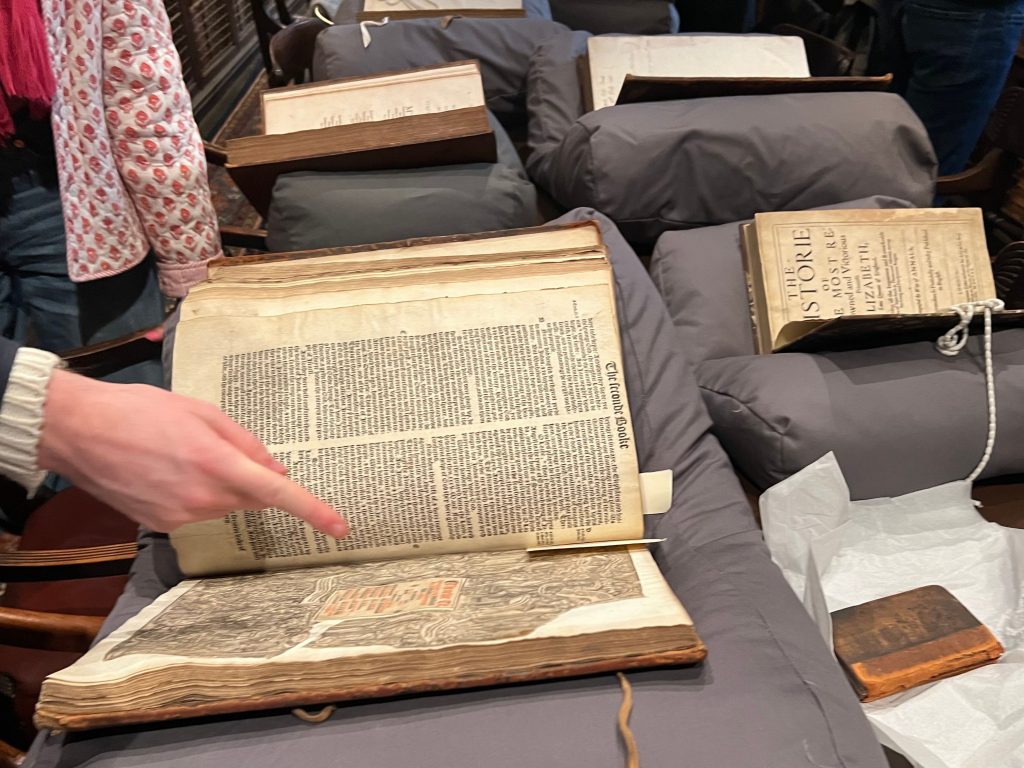Week five’s class at St Edmund Hall offered a fascinating glimpse into the world of library management and the art of caring for collections. Guided by James Howarth, the Hall Librarian, and Emma Carter, the Assistant Librarian, we delved into the practical and philosophical aspects of preserving books—not just for their content, but also for their historical and cultural significance as physical objects.
St Edmund Hall’s library collection is deeply rooted in history. We were introduced to its origins, which date back to the 17th century, when Dr. Thomas Tullie, Principal of the Hall, established a tradition that shaped the library’s foundation. Graduates leaving the Hall were encouraged to donate books or silver worth £5 as a farewell gift. This practice continued under his successors and created a rich and varied collection that reflects the intellectual priorities of those eras.
Today, the Hall’s library is more than a repository of knowledge—it is a time capsule that connects us to generations of scholars and the evolving priorities of academia. We learned how these contributions over the centuries shaped the Hall’s unique character and provided an invaluable resource for both study and research.

One of the key themes of the session was the critical role of preservation in library management. Books are more than just vehicles for information; they are physical artifacts that tell stories of their own. From the craftsmanship of bindings to the materials used in pages, every book carries clues about its origins, purpose, and journey.


During the session, we handled books in various conditions, ranging from pristine examples to fragile volumes showing the wear of time. This hands-on experience brought home the importance of conservation work—not only to protect the contents of the books, but also to preserve their physicality as historical objects.
Our exploration took us to the two different libraries.
The Old Library, tucked away above the chapel. Stepping into the Old Library felt like stepping back in time. Housing volumes dating as far back as the 15th century, the collection offers a snapshot of centuries of academic thought.

The collection includes texts on history, science, literature, geography, and even theology. These books represent a mosaic of intellectual pursuits that mirror the evolution of education at the Hall.


In contrast, the New Library, despite its name, is housed in a structure that predates most of the Old Library’s books. Located in the 12th-century church of St Peter-in-the-East, it is one of Oxford’s oldest churches. This library is a beautiful blend of tradition and modernity. The bookshelves and desks are arranged to echo the layout of church pews, retaining the sacred orderliness of the original space. It is a testament to how historical spaces can be repurposed for contemporary use while still preserving their architectural and cultural significance.




The day ended on a high note—quite literally—with a visit to the bell tower. This unique space, part of the library, is a marvel in itself. Lined with bookshelves that stretch up its walls, the tower combines the functionality of a library with the grandeur of a historical monument.
As we climbed the tower, the experience became even more magical. Reaching the top just as the sun was setting, we were treated to a stunning view of Oxford bathed in golden light. From this vantage point, the city seemed to come alive with its rich tapestry of spires and rooftops, a visual reminder of the centuries of knowledge and tradition it holds.
This session wasn’t just about learning how to care for books—it was about understanding why we care for them. Books are more than containers for words; they are artifacts that carry the weight of history, culture, and craftsmanship.
Exploring St Edmund Hall’s libraries was a journey through time. The Old Library connected us to the intellectual aspirations of the past, while the New Library showed how historical spaces can be reimagined for modern use. In a world increasingly dominated by digital media, this session was a poignant reminder of the irreplaceable value of physical books. They are not just vessels for ideas but objects that tell stories of their own—stories of those who created them, read them, and preserved them.
Leaving the Hall that day, I couldn’t help but feel a sense of gratitude—not just for the books but for the people who dedicate themselves to their care. It’s a labour of love that ensures future generations can continue to be inspired by these treasures.

Bodleian Library book binding Collections Dante Digital Editions early modern Early Modern German edition events German global connections Hans Sachs History of the Book Illuminated manuscripts Incunabula Internship Latin Library liturgy Lucas Cranach Manuscripts Martin Luther medieval Medingen Merton College Middle English Middle High German Old French Palaeography paper parchment Printing Reformation Spanish Taylorian Teaching TEI translation Travel Typesetting UNIQ+ video Weston Library XML Yiddish





